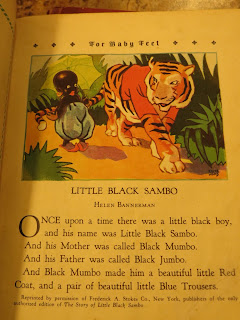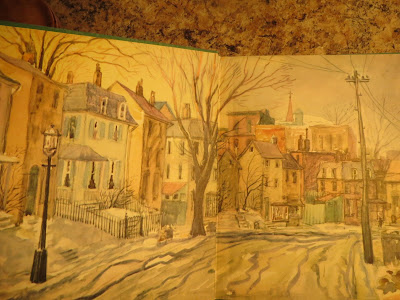What books were being given
to boys and girls as Christmas presents in the year 1928? Many probably
received a set of Book Trails. The
first volume, Book Trails for Baby Feet, begins with “Little Black Sambo,” a story told in many different
editions over the years and revived in three new versions not long ago. It’s a
story that’s been loved and hated and that has given rise to legends in which
some vague, powerful, conspiratorial “They” pull out all the stops to censor
children’s literature by making the story unavailable.
Here are a few facts from the
book world as I have come to know it.
·
Children’s books, read
over and over and not always treated gently, tend to survive in smaller numbers
than adult books, and a family of several children probably had no more than
one copy of a beloved book when the children were small. The likelihood of that
copy having survived is small.
·
Popular and well-loved
children’s books, like other published titles, usually go out of print over
time.
·
Why isn’t a popular book
reprinted? Most publishers of children’s books are conservative business
people. They do not want copyright problems, and they don’t want storms of
social protest -- unless the storms are going to sell books.
But also –
·
Every year publishers
are bringing out new titles for
children.
·
Illustration styles
change over the years, as do parenting methods.
·
Social awareness grows.
Does anyone think the Dick
and Jane readers fell victim to
censorship? Well, actually, a few people probably do think that, but evolving (or at least changing)
theories of education are a more likely explanation. As for why Dick and
Jane books and Little Black Sambo have commanded such high prices on the secondary
(i.e., not new) book market for as long as I’ve been selling used books, the
answer is simple: supply and demand. When people remember books from their own
childhood, want to get their hands on the books again, and the desired titles
are out of print and surviving copies in short supply, prices go up.
It is not a conspiracy. If
booksellers were that canny, we would all be rich.
But those who object to the
character of Little Black Sambo as depicted in the story have a serious point
to make. The little black boy in the pictures presents a stereotype, as does his name and the names of his mother and father, and so the
story fosters continued stereotypical thinking about darker races among young
white readers, while showing young readers of color nothing they can recognize
that relates to their own lives.
Growing social awareness is
obvious in another book that came to my hand recently, Bright April, by Marguerite di Angeli.
As soon as the book is
opened, the illustrated endpapers invite the reader into April’s world,
Philadelphia’s Germantown following the close of World War II. We learn that
she has a sister and two brothers, that her father is a postman, and that she
belongs to a Brownie troop.
In this mid-century African-American family, April helps her father clear
the sidewalk of ice and snow and helps her mother set the dinner table, always
trying to live up to the secret Brownie motto, “D.Y.B.!” There are hints of
difficulties to come when other little girls say unkind things or when April’s
serviceman brother (the year is 1946) writes home that he has been assigned to
laundry duty rather than given an architectural assignment for which he was
educationally trained and eager to execute. Today, perhaps, April’s parents
would give their children more emphatic, less gentle lessons, but de Angeli
certainly left “Little Black Sambo” behind.
And yet, simply comparing
these two fictional characters misses something else. “Little Black Sambo” and April
Bright are completely different kinds
of stories, just as “The Milkmaid and Her Pail,” by Aesop, another story in Baby
Feet, is entirely different from an
almost infinite number of realistic fiction for young people written in the 20th
century. Fairy tales such as “Cinderella” and “Snow White,” feminists point out,
gave starring roles to female stereotypes, not fully realized fictional girls
and women. And what about all the charming princes? Ever meet one in real life
who looked and talked and acted like the ones in fairy tales. And how about all
the wicked stepmothers?
 In fairy tales and fables the
emphasis is on a simple plot, large actions, and lesson to be learned, while
realistic fiction, for readers of all ages, present an ambiguous world peopled
by distinct individuals trying to find their way in it.
In fairy tales and fables the
emphasis is on a simple plot, large actions, and lesson to be learned, while
realistic fiction, for readers of all ages, present an ambiguous world peopled
by distinct individuals trying to find their way in it.
Is there a place in our world
today for fables and fairy tales? That’s a serious question. I wonder what
others think. And where does contemporary YA dystopian literature fall with
relation to fairy tales and realism?









No comments:
Post a Comment